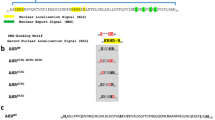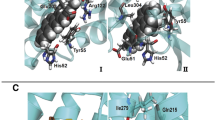Abstract
Purpose
We previously reported that BRCA1 interacts with aryl hydrocarbon receptor nuclear translocator (ARNT) and that this interaction affects TCDD-induced CYP1A1 gene expression (Kang et al., J Biol Chem 281:14654–14662, 2006). In this study we continue this investigation and begin to define the significance of this interaction for the regulation of stress-induced transcription.
Methods
Immunoprecipitations (IPs), western blot (WB) analysis, GST pull-down assays and promoter reporter assays were used to investigate whether the aryl hydrocarbon receptor (AhR) can regulate transcription that is dependent on the activation domain 1 (AD1) domain of BRCA1.
Results
We show that AhR, a transcription factor, can bind specifically to AD1 in the C-terminal region of BRCA1 and affect BRCA1’s ability to regulate transcription activity. We found that xenobiotics that positively and negatively affect AhR’s activity as a transcription factor (e.g., dioxin and α-naphthoflavone, respectively), have similar effects on AhR’s ability to affect AD1-domain-dependent transcription. These physical and functional AhR–AD1 interactions may require the coiled-coil motif in AD1 because point-mutations in this motif reduce these interactions.
Conclusion
Xenobiotic-activated AhR can function in two ways, as a component of the AhR/ARNT transcription factor and a regulator of AD1-dependent transcription. Consequently, BRCA1 has two distinct mechanisms for sensing xenobiotics and regulating AhR-dependent stress responses to these xenobiotics. We speculate that the normal functioning of this interaction could play a role in BRCA1’s tumor suppressing ability.







Similar content being viewed by others
Abbreviations
- ARNT:
-
Aryl hydrocarbon receptor nuclear translocator
- AhR:
-
Aryl hydrocarbon receptor
- BRCA1:
-
Breast cancer susceptibility gene-1
- DMEM:
-
Dulbecco’s modified eagles’ medium
- DMSO:
-
Dimethyl sulfoxide
- FBS:
-
Fetal bovine serum
- IP:
-
Immunoprecipitation
- SEM:
-
Standard error of mean
- WB:
-
Western blot
- AD1:
-
Activation domain 1
References
Andersson P, McGuire J, Rubio C, Gradin K, Whitelaw ML, Pettersson S, Hanberg A, Poellinger L (2002) A constitutively active dioxin/aryl hydrocarbon receptor induces stomach tumors. Proc Natl Acad Sci USA 99:9990–9995
Carver LA, Bradfield CA (1997) Ligand-dependent interaction of the aryl hydrocarbon receptor with a novel immunophilin homolog in vivo. J Biol Chem 272:11452–11456
Dension MS, Nagy SR (2003) Activation of the aryl hydrocarbon receptor by structurally diverse exogenous and endogenous chemicals. Annu Rev Pharmacol Toxicol 43:309–334
Hankinson O (1995) The aryl hydrocarbon receptor complex. Annu Rev Pharmacol Toxicol 35:307–340
Hu YF, Miyake T, Ye Q, Li R (2000) Characterization of a novel trans-activation domain of BRCA1 that functions in concert with the BRCA1 C-terminal (BRCT) domain. J Biol Chem 275:40910–40915
Hu YF, Li R (2002) JunB potentiates function of BRCA1 activation domain 1 (AD1) through a coiled-coil-mediated interaction. Genes Dev 16:1509–1517
Jiang X, Norman M, Li X (2003) Use of an array technology for profiling and comparing transcription factors activated by TNFalpha and PMA in HeLa cells. Biochim Biophys Acta 1642:1–8
Jiang X, Norman M, Roth L, Li X (2004) Protein-DNA array-based identification of transcription factor activities regulated by interaction with the glucocorticoid receptor. J Biol Chem 279:38480–38485
Kang HJ, Kim HJ, Kim SK, Barouki R, Cho CH, Khanna KK, Rosen EM, Bae I (2006) BRCA1 modulates xenobiotic stress-inducible gene expression by interacting with ARNT in human breast cancer cells. J Biol Chem 281:14654–14662
Kang HJ, Kim HJ, Rih JK, Mattson TL, Kim KW, Cho CH, Isaacs JS, Bae I (2006) BRCA1 plays a role in the hypoxic response by regulating HIF-1alpha stability and by modulating vascular endothelial growth factor expression. J Biol Chem 281:13047–13056
Karchner SI, Franks DG, Powell WH, Hahn ME (2002) Regulatory interactions among three members of the vertebrate aryl hydrocarbon receptor family: AHR repressor, AHR1, and AHR2. J Biol Chem 277:6949–6959
Kazlauskas A, Sundstrom S, Poellinger L, Pngratz I (2001) The hsp90 haperone complex regulates intracellular localization of the dioxin receptor. Mol Cell Biol 21:2594–2607
Lupas A, Van Dyke M, Stock J (1991) Predicting coiled coils from protein sequences. Science 252:1162–1164
Lupas A (1996) Coiled coils: new structures and new functions. Trends Biochem Sci 21:375–382
Mimura J, Ema M, Sogawa K, Fujii-Kuriyama Y (1999) Identification of a novel mechanism of regulation of Ah (dioxin) receptor function. Genes Dev 13:20–25
Moennikes O, Loeppen S, Buchmann A, Andersson P, Ittrich C, Poellinger L, Schwarz M (2004) A constitutively active dioxin/aryl hydrocarbon receptor promotes hepatocarcinogenesis in mice. Cancer Res 64:4707–4710
Nebert DW, Gonzalez FJ (1987) P450 Genes: structure, evolution, and regulation. Ann Rev Biochem 56:945–993
Perdew GH, Bradfield CA (1996) Mapping the 90 kDa heat shock protein binding region of the Ah receptor. Biochem Mol Biol Int 39:589–593
Swanson HI, Perdew GH (1993) Half-life of aryl hydrocarbon receptor in Hepa 1 cells: evidence for ligand-dependent alterations in cytosolic receptor levels. Arch Biochem Biophys 302:167–174
Whitlock JP Jr (1999) Induction of cytochrome P4501A1. Annu Rev Pharmacol Toxicol 39: 103–125
Yoo HY, Chang MS, Rho HM (1999) Xenobiotic-responsive element for the transcriptional activation of the rat Cu/Zn superoxide dismutase gene. Biochem Biophys Res Commun 256:133–137
Acknowledgments
Dr. Bae has been supported, in part, by the National Institute of Environmental Health Science, NIH (ES01440-01) and the Susan G. Komen Foundation for the Cure (BCTR119906 and FAS0703858). Drs. Li and Hu have been supported by CA93506 (R. L) and CA118578 (Y. H), respectively. We appreciate Drs. Albert J. Fornace Jr. and Thomas L. Mattson for helpful discussions.
Author information
Authors and Affiliations
Corresponding author
Rights and permissions
About this article
Cite this article
Kang, H.J., Kim, H.J., Cho, CH. et al. BRCA1 transcriptional activity is enhanced by interactions between its AD1 domain and AhR. Cancer Chemother Pharmacol 62, 965–975 (2008). https://doi.org/10.1007/s00280-008-0686-x
Received:
Accepted:
Published:
Issue Date:
DOI: https://doi.org/10.1007/s00280-008-0686-x




